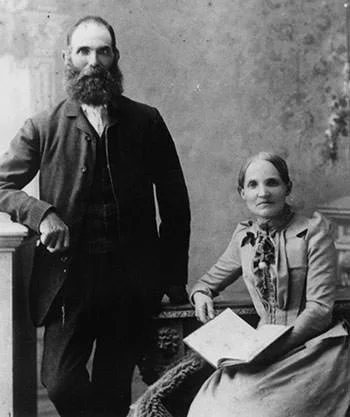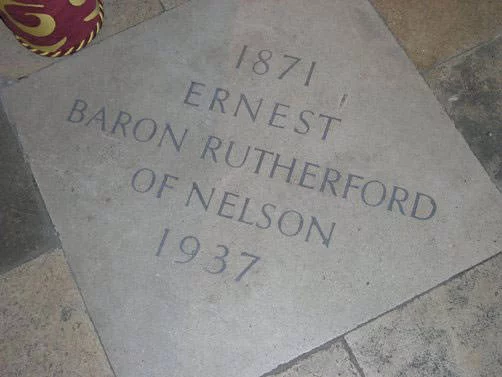Born in a large family with limited means, in New Zealand, Ernest Rutherford went on to become one of the leading scientists of the twentieth century. He is most famous for his model of the atom and for being the first person from Oceania to become a Nobel laureate by winning the Nobel Prize in Chemistry in 1908. Apart from other honours, Rutherford was knighted, served as President of Royal Society and was conferred with the title Baron Rutherford of Nelson. Know about the life, family, education, career as a scientist and death of the Father of Nuclear Physics through these 10 interesting facts.
#1 HE WAS THE FOURTH BORN OF TWELVE CHILDREN
Ernest Rutherford was the son of James Rutherford and his wife Martha Thompson. Martha Thompson was originally from Essex, England while James Rutherford lived in the Scottish city of Perth. James and Martha immigrated to New Zealand when they were young. They met there and married in 1866. Ernest was born on August 30, 1871, in Spring Grove, near Nelson, New Zealand. He was the second of seven sons and fourth of twelve children born to them. James primarily worked as a farmer in New Zealand while Martha was an English school teacher.

#2 HE EARNED HIS BA, MA AND BSC DEGREES FROM THE CANTERBURY COLLEGE
Ernest did his early education at Havelock School before he won a scholarship to attend Nelson College, a state secondary school in Nelson, New Zealand. He excelled in nearly all subjects. Another scholarship allowed him to enter in 1890 the Canterbury College in Christchurch, one of four campuses of the University of New Zealand. Rutherford earned his Bachelor of Arts (B.A.) degree in 1892 and the following year he was awarded a Master of Arts (M.A.) degree with first-class honours in physical science, mathematics and mathematical physics. Rutherford stayed in Canterbury for another year to conduct independent research which earned him a Bachelor of Science (B.S.) degree at the end of 1894.

#3 HE INVENTED A RECEIVER TO DETECT RADIO WAVES
German physicist Heinrich Hertz had detected the presence of electromagnetic radiations we now know as radio waves. Rutherford decided to measure the effect of these waves on magnetized steel needles leading him to invent a sensitive detector for radio waves. Rutherford’s radio receiver became a part of the communications revolution known as wireless telegraphy. It also earned him a major research scholarship to study in England. University of Cambridge had recently changed its rules to allow graduates of other institutions to earn a Cambridge degree. Rutherford decided to work at Cambridge University’s Cavendish Laboratory led by Europe’s leading expert on electromagnetic radiation, J.J. Thomson. He thus was among Cambridge’s first research students.
#4 HE COLLABORATED WITH J.J. THOMSON TO STUDY THE IONIZATION OF GASES BY X-RAYS
Initially at Cambridge, Rutherford improved on his radio receiver. It was able to detect radio waves at half a mile, holding for a short while the world record for the distance over which electromagnetic waves could be detected. Italian inventor Guglielmo Marconi soon became the leading figure in the field of wireless telegraphy and Rutherford’s attentions moved elsewhere. X-rays had been recently discovered by German physicist Wilhelm Conrad Röntgen. J.J. Thomson invited Rutherford to collaborate with him on an investigation of the way in which X-rays changed the conductivity of gases. Their collaboration led to Thomson’s discovery and identification of the first sub-atomic particle, the electron.

#5 RUTHERFORD MARRIED MARY GEORGINA NEWTON IN 1900
In 1898, on Thomson’s recommendation, Rutherford was made professor of physics at McGill University in Montreal, Canada. During his last years at the Canterbury College in Christchurch, Rutherford had met and fallen in love with his landlady’s daughter, Mary Georgina Newton. The couple had been engaged before Ernest left New Zealand. His new job allowed Ernest Rutherford to marry Mary Newton in Christchurch, New Zealand in 1900. The couple’s only child, a daughter named Eileen Mary, was born in 1901. Eileen would go on to marry Sir Ralph Howard Fowler, a British physicist and astronomer. Rutherford’s daughter died after giving birth to her fourth child in 1930, leaving him devastated.
#6 HE DISCOVERED ATOMS WERE NOT INDESTRUCTIBLE
After his move to McGill University, where he was provided with his own research laboratory, Rutherford began studying the radiation emitted by uranium. He was joined by English chemist, Frederick Soddy, who would go on to win the Nobel Prize in Chemistry in 1921. With Soddy, Rutherford developed the disintegration theory as an explanation for radioactivity. He discovered that atoms were not indestructible as they were believed to be and that radioactivity involved the spontaneous disintegration of atoms. Rutherford coined the terms alpha, beta and gamma for the three most common types of nuclear radiation, which have since been in standard use. In 1907, Rutherford discovered that radioactive elements have half-lives, coining the term half-life period to identify the phenomenon.

#7 RUTHERFORD WAS THE FIRST PERSON FROM OCEANIA TO WIN A NOBEL PRIZE
While at McGill, Rutherford was becoming increasingly renowned in the world of physics. He admitted many research students to his laboratory. They included women, who usually found it difficult to be recognized yet due to their small numbers in the world of science. In 1908, Ernest Rutherford was awarded the Nobel Prize in Chemistry “for his investigations into the disintegration of the elements, and the chemistry of radioactive substances”. Rutherford was the first person from the continent of Oceania to win a Nobel Prize. He is also considered the first Canadian Nobel laureate and, as of 2016, remains the only laureate born in the South Island, the larger of the two major islands of New Zealand.

#8 HIS GREATEST ACHIEVEMENT IS THE DISCOVERY OF THE ATOMIC NUCLEUS
In 1907, Rutherford returned to Britain to take the chair of physics at the University of Manchester in Manchester, England. Here, in 1909, along with researchers Hans Geiger and Ernest Marsden, he carried out one of the landmark experiments in science – the gold foil experiment. Rutherford interpreted the data of the experiment to formulate in 1911 the Rutherford model of the atom with the bulk of the mass concentrated in a very small charged nucleus, orbited by low-mass electrons. Rutherford’s model was instrumental in developing a coherent base for the development of atomic physics and nuclear physics.

#9 HE WAS CONFERRED WITH THE TITLE BARON RUTHERFORD OF NELSON IN 1931
Rutherford was knighted in 1914 becoming Sir Ernest Rutherford, and in 1931 he was made a British lord, receiving the title Baron Rutherford of Nelson. During the First World War, he worked on a top secret project to solve the practical problems of submarine detection by sonar. In 1919, Rutherford became professor of experimental physics and succeeded his mentor J.J. Thomson as director of Cavendish Laboratory at the Cambridge University. Between 1925 and 1930 he also served as President of the Royal Society of London. Rutherford was an inspiring figure to young scientists and an unusually large number of his research workers at various institutes went on to win Nobel Prizes, including James Chadwick, Niels Bohr, Otto Hahn and Frederick Soddy.

#10 RUTHERFORD DIED DUE TO COMPLICATIONS OF A STRANGULATED HERNIA
In the mid-1930s, Rutherford had a hernia but was negligent in getting it cured. In 1937, it became strangulated, causing him to be violently ill. Rutherford was admitted to a hospital for an emergency operation but died four days later on October 19, 1937 in Cambridge, England. He was 66 years old. He was buried in Westminster Abbey, near Isaac Newton and other illustrious British scientists. Rutherford’s work in radioactivity and structure of the atom became the basis of further research in the fields. Numerous parks, streets and buildings have been named after him. A crater on the moon and another on Mars have been named Rutherford in his honour. Also, Element 104 is named Rutherfordium after him.

ERNEST RUTHERFORD AND NIELS BOHR
In 1911, Niels Bohr visited the Cavendish Laboratory headed by Sir J.J. Thomson but was unable to attract the interest of the esteemed scientist. However, the following year, the 26-year old Bohr, was able to impress Ernest Rutherford while working as a research student in his laboratory at the University of Manchester. This was the start of a 25-year old friendship between the two. Niels Bohr went on to improve the Rutherford Model of the atom by applying Max Planck’s quantum theory to it and forming the revolutionary Bohr Model of the atom. The friendship between Bohr and Rutherford grew with time, and they and their wives often vacationed together in later years.


This is a really good article I love it so much.
Thanks for your appreciation.